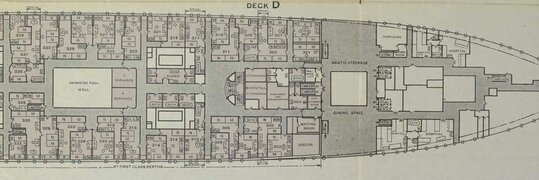In the biography of
Shawneene George Joseph, she mentions that the Syrian/Lebanese immigrants in 3rd class had their own dining saloon.
IMO, one has to be careful with such "claims". In the first place, have Mrs Joseph's words been translated correctly, especially if she was speaking with a local dialect? She might have meant exactly what Michael says below - that the Syrian/Lebanese passengers had simply "reserved" a section of the Third Class dining room for their group, understandable because of the alien environment and communications limitations. But that would not have meant that the area was "theirs" or anything. In fact, depending on the day they might have sat more or less together but in different parts of the dining room.
I cannot imagine that the Syrian/Lebanese passengers were assigned their own dining room. But I think it is possible that the syrian/lebanese families had their own corner in one of the parts of the dining room where they sat at several tables.
Exactly. The same thing probably applied to the Irish, Scandinavian and other groups of passengers for the same reasons. For example, very little is known about the on-board movements of the 38 Bulgarian passengers, all travelling in Third Class, but they too must have congregated and eaten their meals somewhere. If there had been even a single survivor from among them (unfortunately, there wasn't), we would have had more information and related stories.
After reading a certain badly written book about the Syrian-Lebanese passengers on board the
Titanic, I got a strong impression that the author did not really bother to verify statements made by descendants of the survivors or, in some cases recorded statements of the the survivors themselves. There are all sorts of improbable claims including several people being shot etc.....but we've been though all that before.
I have made the point before that the passenger demographics of East-to-West crossings of the
Olympic class of liners - or indeed
any large ship of that kind - could not be predicted and could well be highly variable even from one day to another. That would be specially true of the national origins of the immigrants in Third Class; if the
Titanic had not sunk on its maiden voyage, its next Southampton-Cherbourg-Queenstown-New York trip could well have contained a lot of Italians, Spaniards and Egyptians in Third Class. Under such circumstances, it would not have been possible to even informally designate dining areas based on nationalities, especially since most of them aspired to become
bona fide Americans sooner or later.

